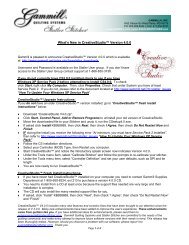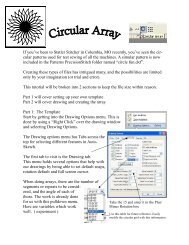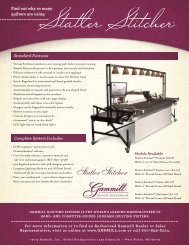You also want an ePaper? Increase the reach of your titles
YUMPU automatically turns print PDFs into web optimized ePapers that Google loves.
136<br />
Getting Started with CreativeStudio<br />
pattern and prompts for pulling up the bobbin thread.<br />
9. Click OK when ready to quilt. If multiple patterns were moved into the boundary,<br />
they will stitch in the order they were moved. At the end of the quilting sequence, you<br />
will be prompted to pull up the bobbin thread and click OK. It doesn't matter how the<br />
bobbin thread is pulled up, secured or trimmed. Just be sure to click OK because it<br />
completes this process.<br />
Tip: Be Patient! CS will take a little time before it moves to the<br />
beginning of the pattern and starts to quilt. CS needs to examine<br />
every TRIM boundary and identify where each additional tie-off<br />
goes. Be Patient when doing a restart too - it takes time.<br />
Quick Reference Trim Inside<br />
178<br />
4.4.2 Pantographs using Edge_To_Edge<br />
Edge To Edge pantographs are continuous line designs stitched repeatedly across<br />
the quilt. Many pantographs span the entire quilt but they can also be confined to an<br />
inside area or even a border. Aligning the rows of a pantograph can be tricky,<br />
especially after rolling the quilt so CS has a special feature (E2E Continue) to help<br />
do that successfully.<br />
Feature: Edge to Edge (E2E)<br />
Assumptions: The machine is threaded, bobbins wound, belts engaged and<br />
patterns have been added to the project.<br />
Prep Step #1.) Measure the quilt length and width accurately before loading the quilt.<br />
If you are leaving a margin at the top and bottom, be sure to reduce your total quilt<br />
length by this amount. Also it is a good idea to reduce the length a little to<br />
accommodate shrinkage caused by the quilting. This could be from 1% to 5%,<br />
depending on the fabrics, batting and quilting density.<br />
Prep Step #2) Load the quilt and baste the outer edges.<br />
Prep Step #3) Choose a pattern and think about the scale. Large scale, open quilting<br />
results in a more supple quilt and small scale, dense quilting is a bit stiffer.<br />
Prep Step #4) Change the pattern details (height and width) to reflect the scale you<br />
prefer.<br />
Pantograph patterns with irregular outer edges are designed to nest together. This





